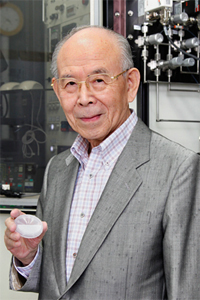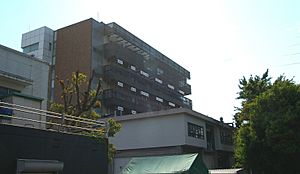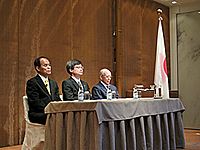Isamu Akasaki facts for kids
Quick facts for kids
Isamu Akasaki
|
|
|---|---|
| 赤﨑 勇 | |

Isamu Akasaki
|
|
| Born | January 30, 1929 Chiran, Kawanabe District, Kagoshima Prefecture, Empire of Japan
|
| Died | April 1, 2021 (aged 92) |
| Nationality | Japanese |
| Alma mater | Kyoto University Nagoya University |
| Awards | Asahi Prize (2001) Takeda Award (2002) Kyoto Prize (2009) IEEE Edison Medal (2011) Nobel Prize in Physics (2014) Charles Stark Draper Prize (2015) |
| Scientific career | |
| Fields | Physics, Engineering |
| Institutions | Meijo University Nagoya University |
Isamu Akasaki (赤﨑 勇, Akasaki Isamu, January 30, 1929 – April 1, 2021) was a Japanese engineer and physicist. He was famous for his work with semiconductor technology. He won the Nobel Prize for inventing the bright blue LED in 1989. This invention used a special material called gallium nitride (GaN).
Because of his amazing work, Akasaki received many awards. These include the Kyoto Prize in 2009 and the IEEE Edison Medal in 2011. In 2014, he shared the Nobel Prize in Physics with Hiroshi Amano and Shuji Nakamura. They won for creating "efficient blue light-emitting diodes, which has enabled bright and energy-saving white light sources." In 2021, Akasaki also received the Queen Elizabeth Prize for Engineering. This was for his role in developing LED lighting.
Contents
Early Life and Education
Isamu Akasaki was born in Chiran, Kagoshima Prefecture, Japan. He grew up in Kagoshima City. His older brother, Masanori Akazaki, was also an electronics researcher.
Isamu finished middle school in 1946. He then went to a higher school, which is now Kagoshima University. He graduated in 1949. In 1952, he earned a degree in Chemistry from Kyoto University. During his university days, he loved exploring shrines and temples. He also enjoyed hiking in the mountains. He had a very fulfilling time as a student. Later, in 1964, he earned his Doctor of Engineering degree from Nagoya University.
Amazing Research on Blue LEDs
Akasaki began working on blue LEDs using GaN in the late 1960s. He worked at Matsushita Research Institute Tokyo, Inc. (MRIT). He slowly made the GaN crystals better. He also improved the design of the devices. He chose a method called MOVPE (metalorganic vapor phase epitaxy) to grow the GaN.
In 1981, he started fresh at Nagoya University. In 1985, he and his team made a big breakthrough. They successfully grew high-quality GaN on a sapphire base. They did this by using a new method called the low-temperature (LT) buffer layer technology.
This high-quality GaN allowed them to make more discoveries.
- In 1989, they found a way to make p-type GaN. This was done by adding magnesium (Mg) and using electron beams.
- In the same year, they created the very first GaN p-n junction blue/UV LED.
- They also learned how to control the flow of electricity in n-type GaN. This was done by adding silicon (Si).
- These discoveries helped them design more efficient light-emitting structures.
In 1990, they achieved stimulated emission from GaN at room temperature. This was a major step towards creating lasers. By 1995, they developed stimulated emission at a specific light wavelength (388 nm). This was using a special device with layers of AlGaN/GaN/GaInN.
They also studied how tiny particles behave in these materials. They confirmed the quantum size effect in 1991. They also showed the quantum confined Stark effect in 1997. In 2000, they explained how the direction of the crystals affects their properties. This led to new ways of growing GaN crystals for even better light sources.
Nagoya University Akasaki Institute
Isamu Akasaki's inventions led to many important patents. The money from these patents helped build the Nagoya University Akasaki Institute. It opened on October 20, 2006. The institute displays the history of blue LED research. It also has offices and labs for new research. Akasaki's own office was on the top floor. The institute is a key part of Nagoya University's research area.
Professional Journey
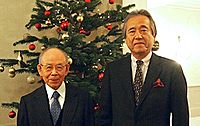
Akasaki started his career in 1952 at Kobe Kogyo Corporation. He then worked at Nagoya University from 1959 to 1964 as a researcher and professor. From 1964 to 1981, he led research at Matsushita Research Institute Tokyo, Inc.
In 1981, he returned to Nagoya University as a professor. He stayed there until 1992. During this time, he led important projects. These projects focused on developing blue LEDs and short-wavelength lasers. These projects were supported by the Japan Science and Technology Agency (JST).
He also taught as a visiting professor at Hokkaido University. From 1996, he led the "High-Tech Research Center for Nitride Semiconductors" at Meijo University. He became a Professor Emeritus at Nagoya University in 1992. He also continued to teach at Meijo University. He was the Director of the Research Center for Nitride Semiconductors at Meijo University. He also worked as a Research Fellow at the Akasaki Research Center of Nagoya University.
Death
Isamu Akasaki passed away on April 1, 2021, at the age of 92. He died from pneumonia.
Honors and Awards
Isamu Akasaki received many awards for his groundbreaking work.
Scientific and Academic Awards
- 1995 – Heinrich Welker Gold Medal
- 1998 – C&C Prize
- 1998 – Rank Prize
- 1999 – Gordon E. Moore Medal for Outstanding Achievement in Solid State Science and Technology
- 2001 – Asahi Prize
- 2002 – Takeda Award
- 2009 – Kyoto Prize in Advanced Technology
- 2011 – Edison Medal
- 2014 – Nobel Prize in Physics (shared with Hiroshi Amano and Shuji Nakamura)
- 2015 – Charles Stark Draper Prize
- 2021 – Queen Elizabeth Prize for Engineering
National Honors
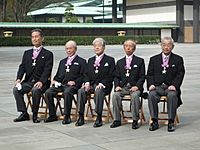
- 1997 – Medal with Purple Ribbon
- 2002 – Order of the Rising Sun, Gold Rays with Neck Ribbon
- 2004 – Person of Cultural Merit
- 2011 – Order of Culture
See also
 In Spanish: Isamu Akasaki para niños
In Spanish: Isamu Akasaki para niños
- List of Japanese Nobel laureates
- List of Nobel laureates affiliated with Kyoto University


